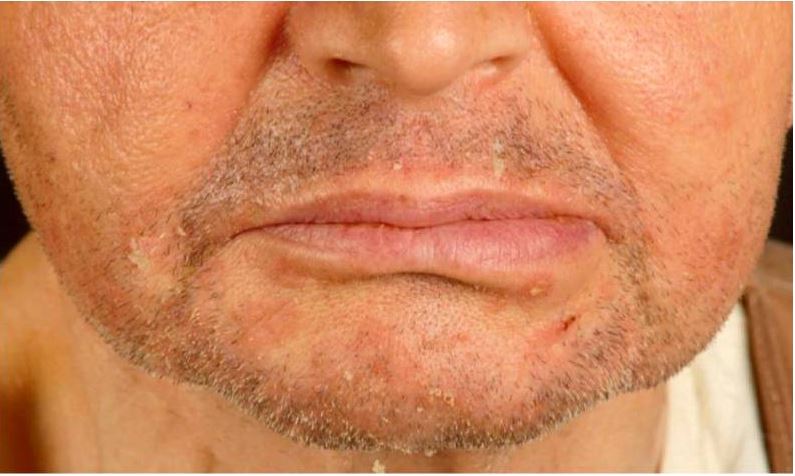Playlist
Show Playlist
Hide Playlist
Derma Case: 41-year-old Woman with Facial Rash
-
Slides Disorders of sebaceous and apocrine glands.pdf
-
Download Lecture Overview
00:01 Next, let's talk about disorders of sebaceous and apocrine glands. 00:06 Before we jump into a case, we should just do a quick review of the glands of the skin. 00:10 First off, we have the sebaceous glands and these are responsible for making sebum and putting it into hair follicles. 00:17 Sebum is an oily substance that's designed to lubricate and waterproof the skin and the hair of mammals. 00:24 And then we have the eccrine and apocrine glands. 00:27 Each one of these are essentially sweat glands that are releasing sweat directly under the skin or providing sweat around hair follicles themselves. 00:36 With that primer, let's jump into a case. 00:39 Alright, so we have a 41-year old EMT with no significant past medical history who's now presenting with a facial rash. 00:47 She does take an oral contraceptive pill but otherwise takes no medications. 00:51 She drinks one to two glassess of wine every night and she has noticed that the rash seems to be more noticeable on very hot days and when she eats spicy food. 01:00 She remembers having problems with acne during high school but this largely resolved in her early 20's and she doesn't understand why it seems to be returning now. 01:08 Family history is non-contributory and on review of systems, she denies myalgias, there's no arthralgias, fevers, weight loss or dysphagia. 01:16 She does however, report some red, itchy eyelids bilaterally for the past few months, denies any blurred vision. 01:24 On exam, we see a fair complexion, she has numerous erythematous papules on a symmetric, confluent erythematous base, diffusely spread across her nose and medial cheeks. 01:36 There are some scattered telangiectasias but no pustules and the remainder of the skin exam is within normal limits. 01:44 So with that history in physical, which of the following is the most likely diagnosis? Well, frist off, acne vulgaris. 01:53 We are told that she had history of acne as a young woman. 01:56 And of course, acne is the most common skin condition in young people, 85% of young people will experience acne at some point. 02:04 So we'll have to keep that one on our list and talk about it a bit more later. 02:10 Acne rosacea, this affects about 10% of fair skinned people. 02:15 She is fair-skinned and 10% is a decent prevalence. 02:19 In addition, it does typically present with chronic facial redness and papules which also sounds to fit the description and the question is whether or not it's associated with this eye lid symptoms that she is describing. 02:31 So, let's keep that one on our list too. 02:35 Next stop, dermatomyositis. 02:37 Well, is the lesion she's reporting around her face, something to do with the heliotropic rash that we think of with dematomyositis? We have to keep that one on our list too and talk about it more later. 02:48 Lupus, so again, this rash that's going to cross her cheeks makes me think of that malar rash, typical of acute cutaneous lupus erythematosus. 02:58 So, our patient also fits the right demographic though ideally it would be an African-American and probably a bit younger. 03:04 Nonetheless, this one's gonna stay on the list too. 03:07 And finally, seborrheic dermatosis. 03:09 This can affect people of any age. 03:12 It often involves the face and including the nasolabial folds, potentially the eyebrows, the eyelids. 03:17 So, this strong association between seborrheic dermatosis and all of these features makes me obligated to leave that on our list as well, Alright, let's go through each one in turn, starting with acne vulgaris.
About the Lecture
The lecture Derma Case: 41-year-old Woman with Facial Rash by Stephen Holt, MD, MS is from the course Miscellaneous Skin Disorders.
Included Quiz Questions
Which of the following is associated with acne rosacea?
- Eyelid involvement
- Constitutional symptoms
- Proximal muscle weakness
- Arthritis
- Heliotropic rash
Which of the following skin manifestations is characteristic of systemic lupus erythematosus?
- Malar rash
- Heliotropic rash
- Keratoderma blennorrhagicum
- Erythema nodosum
- Ecthyma gangrenosum
Customer reviews
5,0 of 5 stars
| 5 Stars |
|
5 |
| 4 Stars |
|
0 |
| 3 Stars |
|
0 |
| 2 Stars |
|
0 |
| 1 Star |
|
0 |





